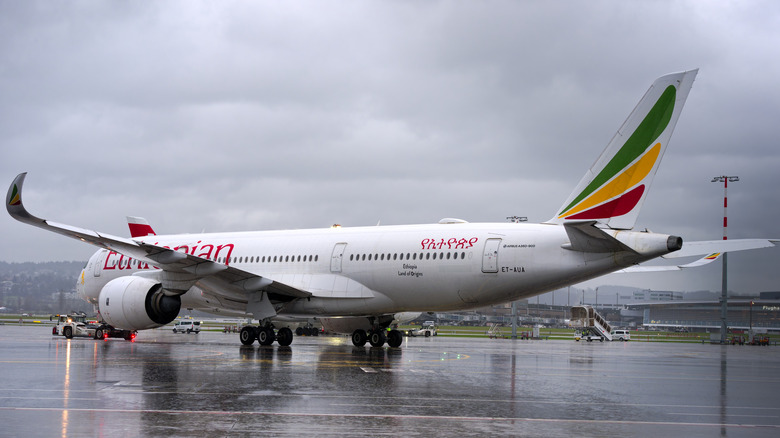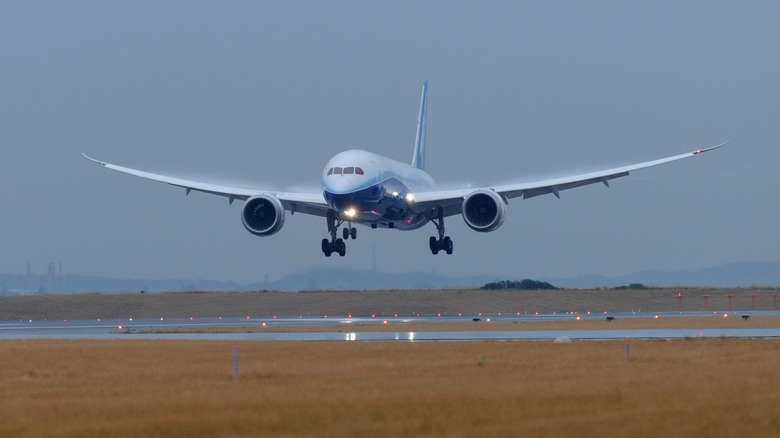Why Do Airplane Wings Bend During Bad Weather? (And How Far Can They Go?)
There's no denying just how critical aircraft wings are. For one, they provide storage for an aircraft's fuel that keeps it a safe distance from the cabin containing passengers and crew. This saved 80 lives in the case of Delta Flight 4819, when the detached wing of the plane exploded during a disastrous landing in Toronto in February 2025. An aircraft's wings also contribute much of the crucial lift that enables a plane to fly. They are designed to resist some of the pressure they take on over the course of a flight that comes from bad weather like thunderstorms and general turbulence.
Airplanes are predominantly fixed-wing aircraft, which means those all-important wings are attached to the aircraft's fuselage and do not move during operation. A plane's wings may not flap, but it's also critical that they're not entirely immobile either. If this were the case, the force from turbulence would be delivered straight to the cabin. Instead, a plane's wings are designed with flexibility to help absorb and soften some of the force.
Without this flexibility, it would be a rougher ride for passengers and would also increase pressure on crucial connections. Should that pressure get too high, it could break the wings like an oak tree that snaps in high winds. For this reason, the ability to bend is very important. The Airbus AS50 XWB's designers, for instance, ensured that its wings could move up to 17 feet from their starting position.
How do the Airbus A350's wings bend so far?
Compared to many forms of ground transport like driving, airplanes are one of the safest ways to travel. Safety checks begin long before flying, though, with manufacturers subjecting every aircraft to stress tests that ensure they're fit for eventualities they're likely (and unlikely) to experience in the course of a flight. For example, to determine that the Airbus AS50 XWB's wing could bend 17 feet, its designers rigged up a tough test for the aircraft.
It was subjected to what Airbus refers to as static ground testing. In a 2013 clip demonstrating the process, Airbus' A350WB ES Test Manager Emmanuel Bodin explained that the tests are designed to push and pull the wings to their extremes to see how they hold up. The fact that an Airbus A350's wings are resilient enough to bend as far as the approximate length of a Chevrolet Impala is astonishing enough, but there are aircraft capable of even more impressive feats of agility.
The extreme and surprising flexibility of some aircraft wings
Though airplane wings are indeed very flexible, this doesn't mean you'd want to be in a situation where they're pushed to their limits. Fortunately, there isn't really a plausible situation during a typical flight in which you would be. This is because there is a buffer of sorts in place. As retired airline captain John Cox explains in USA Today, "Aircraft designers calculate the maximum stress they anticipate a wing will experience in flight, then make it able to withstand 50% more as a safety margin."
That means wings can flex to extremes because they're excessive by design. "During testing," Cox explained, "the Boeing 787 wings flexed 26 feet upward before failing." Clearly, this position wouldn't be desirable in an actual flight. However, these wings are designed with so much leeway for a reason: An aircraft with seriously damaged wings is extremely vulnerable. Though it's possible for an aircraft such as an F-15 to land with just one wing, this part of the plane is vital to an aircraft's performance and it's very difficult to maintain control without its wings.
This is why aircraft wings are both flexible and strong, forged from aluminum or composite metals, and designed with a strong structure of spars supporting them. In Ask Captain Lim, veteran aviator Captain Lim Khoy Hing puts it this way: "It can be said that the aircraft is attached to the wings rather than the other way round."


